One Ocean Film Festival Earmarked to Support Environmental Education – April 24, 2021

After a year that felt like “everything on hold,” we are happy to announce a resumption of our annual One Ocean Film Festival. Due to ongoing challenges with COVID restrictions, we are changing the venue this year and shortening the duration.
Originially scheduled for March of last year, Eco-Alianza’s third One Ocean Film Festival is now slated as a one-evening event honoring Earth Day, to take place Saturday, April 24. Proceeds from the event will be earmarked specifically to support Eco-Alianza’s expanding environmental education programs (more details below).
This year’s event will be held outdoors, under the stars, on the lovely private grounds of Rancho El Jaral. Seating will be strictly limited, so the event will necessarily be by reservation only, responding to an invitation. Invitations will include information on how to donate in advance (suggested minimum donation $50 per person). Please request an invitation by sending an email to Mark.Hufford@ecoalianzaloreto.net . Invitations will go out by email in mid- to late March. We cannot accept payment at the door. Patrons who previously reserved seating prior to the event last March will receive first priority.

Richard Jackson
The evening will begin with socializing over a light meal or appetizers prepared by the master chefs of Hotel La Mision as the sun sets over the mountains. After sunset the program will get underway with stunning new images and video from wildlife photographer Richard Jackson, celebrating the waters and deserts of our treasured Loreto.
Next up, a selection of special clips and engaging stories from “La Recua,” a film project by Saddling South’s Trudi Angell, who in December was honored with Eco-Alianza’s 2020 Environmental Stewardship Award.
La Recua follows Darío Higuera Meza, a traditional saddle maker in Baja California, Sur, Mexico, who in 2018, the year he turned 70, traveled 200 miles in 20 days by mule-back, herding a pack train of donkeys from an oasis in the heart of the Sierra de la Giganta, all the way to La Paz. He and his family packed a load of Goat Cheese, Dates, Sugar-cane Candy, and 10 gallons of famous Comondú Wine… just for the sake of history!

Photo courtesy of Alejandro Rivas
Members of the La Recua team (left to right): Sergio Castro (main editor), Andres Ozawa (script and editor), Trudi Angell, Fermin Reygadas (historian, standing behind Trudi), Darío Higuera (subject of the film), and Alejandro Rivas (cinematographer).
Our feature for the evening will be a new film by Emmy-winning cinematographer Johnny Friday, “Sea Lion Rescue.” The documentary chronicles rescue operations by a team of conservationists and veterinarians to save injured sea lions on the islands near La Paz.
In a race against terrible odds, the team overcomes awful weather, seemingly impossible logistics, and unpredictable animal behaviors. In this heartwarming adventure, veterinary surgeon Daniela Bárcenas joins committed Mexican authorities from CONANP and PROFEPA, along with Eréndira Valle, founder of Mexican nonprofit Rescate de Lobos Marinos and her volunteers.

Johnny Friday, Eréndira Valle, and Daniela Bárcenas
Details are still being finalized, but we expect Johnny Friday, Eréndira Valle, and Daniela Bárcenas to be on hand to answer questions and discuss the film. Click here to view a trailer. Free popcorn will be available during the films and beer and wine will be available for donations.
Most Eco-Alianza programs are supported primarily through grants from our partner foundations. Grants for environmental education programs in Mexico, however, are few and far between and very competitive. Accordingly, our film festival is our best opportunity to financially support this expanding program. We met the challenges of this past year by expanding our environmental education workshops to begin reaching an international online audience (see the September Soundings). Equipment to expand and professionalize our live-streaming capabilities is an essential infrastructure investment in these pandemic times! As already proven, these capabilities will vastly enhance our outreach education efforts.
We are currently seeking environmental education enthusiasts (individuals and also businesses) to help underwrite this event. Event “Producers” and “Directors” will receive special recognition in several ways, as well as the knowledge that they are directly supporting efficient and impactful environmental education programs. For information on underwriting levels, please email Mark.Hufford@ecoalianzaloreto.net .
We look forward to seeing you on April 24 and to sharing these great cinematic stories. More information will be forthcoming in Soundings at the end of March.
Sea Turtle Hatch-out Adds to a Strong 2020 Year for PNBL Wildlife
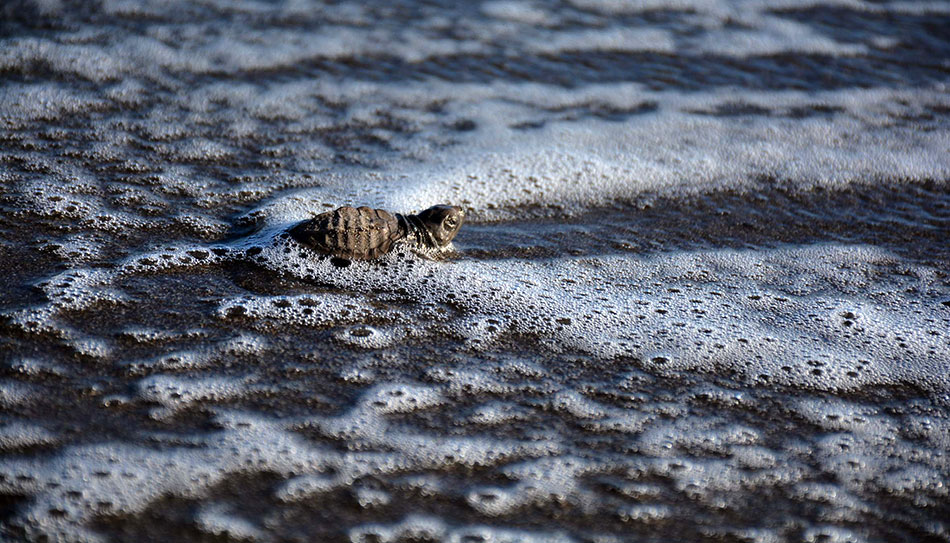
Eco-Alianza staff photos
Several residents of North Loreto, south of Arroyo Candelaria, were surprised in a good way on December 29 when their morning walk revealed newly hatched baby sea turtles clawing their way to the surface and preparing to depart their nest for their sprint to the sea. Eco-Alianza supporters had delightedly discovered the nest being laid many weeks prior, and biologists from Parque Nacional Bahía de Loreto (PNBL) had marked it for protection and were monitoring its expected hatch date.
A quick call to the Park brought eager Park employees who ensured that the hatchlings were not picked off by gulls or crabs before reaching the sea. Several Eco-Alianza staff members and friends also arrived within minutes and enjoyed witnessing the hatch-out miracle that has been unfolding for millenia.
Statistics from that nest on the beach just north of Loreto were added to those from other monitored nests, and one additional 2020 nest that hatched on January 14 at Playa La Negrita. A total of 67 monitored nests yielded 1,302 live hatchlings who began their lives this past year in Loreto. Park biologists early last month also revealed encouraging results from their 2020 monitoring of three other popular species within the Park.
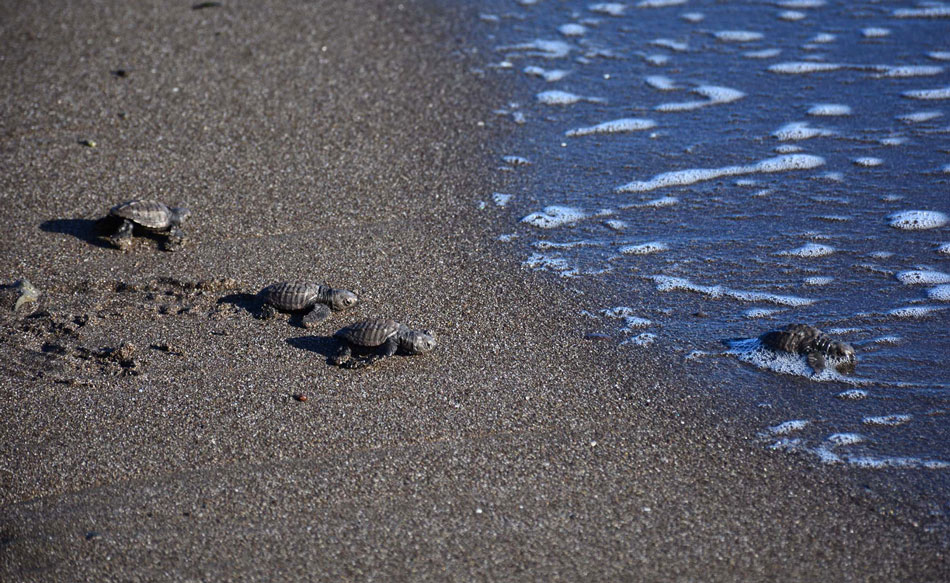
Yellow-footed Gulls may not be as cute as baby sea turtles or as impressive as Blue Whales, but they are, indeed, quite unusual. Until the 1960s they were thought to be a subspecies of the Western Gull, but genetic analysis proved that they are an entirely distinct species, endemic to the Gulf of California, which is the only place they nest. Many scientists consider them to be the Gulf of California’s only endemic seabird species. The 2020 survey by Park biologists revealed 318 nests within the Park, producing 849 eggs. Average clutch size of 2.74 eggs was up from 2.6 the previous year.
The winter survey of the California Sea Lions on Isla Coronados documented more than 220 individual sea lions in the colony.
And the 2020 count of Blue Whales, probably the largest animal ever to inhabit the planet, included 13 females, 8 males, and 7 of undetermined sex. Markings enabling observers to identify individuals have shown one female whale to have returned to the Bay of Loreto National Park area for at least 35 years (identified in 2020 and in 12 other years, three times with offspring swimming alongside).

Photo courtesy of Richard Jackson
As we reported in Soundings last April, Blue Whale numbers increased dramatically in 2020, perhaps due to unusual cold water currents that resulted in a lot more krill, which Blue Whales eat. The 2018 count was a total of 11 individual whales, followed by 13 in 2019. The 2020 count of 28, then, represents more than a doubling of observed Blue Whale numbers within the Park compared to the previous year.
And wildlife survey results weren’t the only good news at PNBL last year. México’s National Commission on Protected Natural Areas (CONANP) and the Secretariat of Environment and Natural Resources (SEMARNAT) released the results of a long-awaited comprehensive evaluation of management effectiveness of the country’s Protected Natural Areas (ANP’s).
Out of 129 ANP’s evaluated, only eight nationwide received the highest management effectiveness rating, that of “sobresaliente” or Outstanding. The Bay of Loreto National Park (PNBL) was one of the eight, and the only one in its region, Baja Peninsula and North Pacific. PNBL, in fact, was one of only two national parks in the country to receive the highest rating.
PNBL’s director, Israel Popoca, said he is proud of the Park’s 11 staff members but is also quick to credit the community and all users of the Park for its success. “The Bay of Loreto National Park is not only the employees of CONANP, it is all the people who use the Park and value it,” he said.
Israel called Eco-Alianza “key partners in the management of this ANP,” citing its “work in environmental education, water quality testing, fostering the identity of the local community with the Park, being the link with the resident community, supporting monitoring activities, and showing the Park’s biodiversity through Richard Jackson’s magnificent images, among other things.”
El Pescador Adds to Food Security Program with Year-end Donation
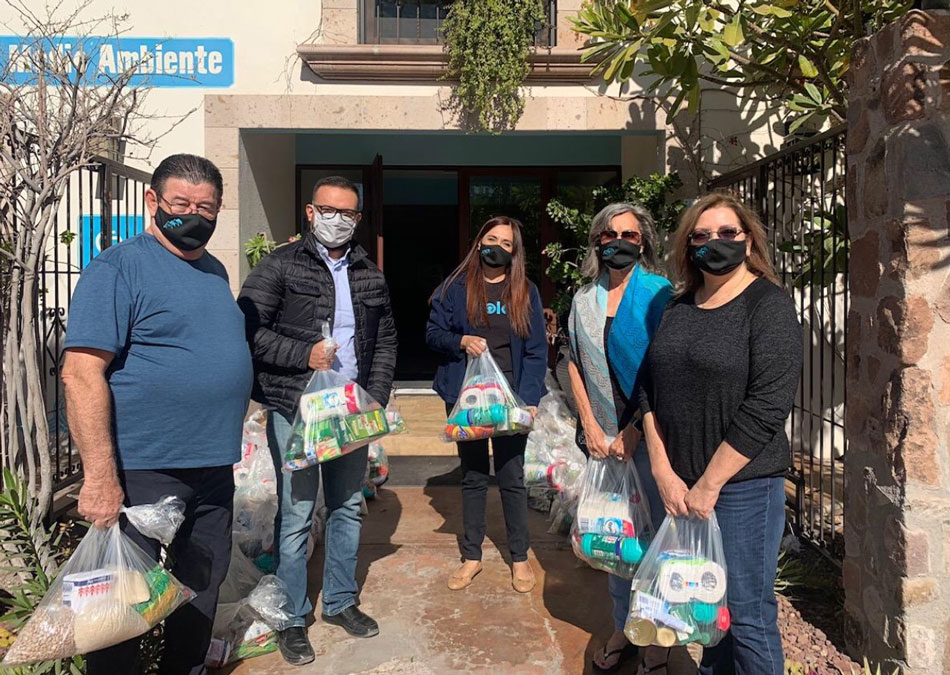
Eco-Alianza staff photo
Eco-Alianza passed El Pescador’s donation along to Caritas and Misión de Nuestra Señora de Loreto Conchó. Pictured (left to right): Arq. Yvo Arias Salorio (Eco-Alianza Board Chairman), Fr. Javier Martinez Garcia of the Misión, Maria Quintero (Eco-Alianza Sr. Program Officer), Linda Kinninger (Eco-Alianza Treasurer and co-Founder), Graciela Garcia (Caritas)
In the December 2020 Soundings we reported highlights of Eco-Alianza’s Final Report on our six-month “Temporary Emergency Food Assistance Program for the Unemployed,” supported by more than 350 donors whose contributions were matched 2:1 by Christy Walton’s Alumbra Innovations Foundation through the International Community Foundation.
The program delivered a total of 14,522 despensas (food “pantries”) to support 2,396 Loretano families through 11 locally-owned stores participating as suppliers/distributors. Every cent of contributions went to purchase food and direct expenses of distribution, with all staffing costs covered by 2019 Eco-Alianza GALA funds.
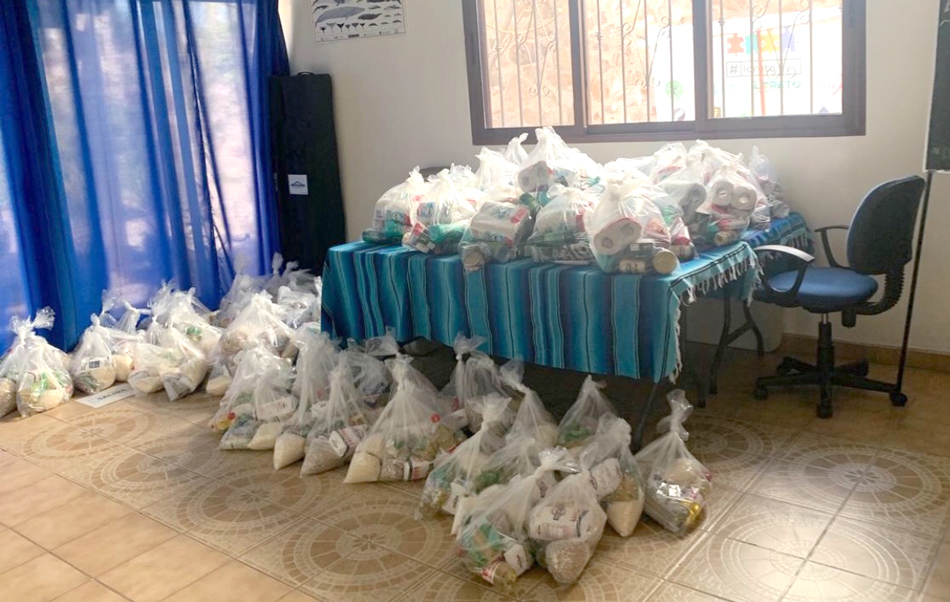
Eco-Alianza staff photo
Additional donations from El Pescador owner Gilberto Amador Davis
At the end of the year, El Pescador Supermercado donated an additional 50 despensas to Eco-Alianza, which were passed through to Caritas with an additional donation to supplement their ongoing food security program.
Liz Ramirez Joins Eco-Alianza Advisory Board
 Elizabeth “Liz” Ramirez late last month accepted a position on Eco-Alianza’s Advisory Board. She has moved to Loreto full-time and is the new owner of the Hotel Casa Mangos on Calle Madero in downtown Loreto.
Elizabeth “Liz” Ramirez late last month accepted a position on Eco-Alianza’s Advisory Board. She has moved to Loreto full-time and is the new owner of the Hotel Casa Mangos on Calle Madero in downtown Loreto.
Liz is a retired elementary school principal, and for many years has been very active with the Sister Cities program in Hermosa Beach, CA, most recently serving as its President. Loreto and Hermosa Beach have been Sister Cities since 1967, with a strong student cultural exchange program and tremendous support for Loreto’s medical and emergency services.
Liz expects to remain active with the Sister Cities group, and brings a wealth of experience to her new role with the Eco-Alianza family. Welcome!
Dr. Winifred “Fred” Frick Makes Rare Bat Discovery in Western Africa

Photo courtesy Bat Conservation International
Dr. Frick holds one of the two specimens of Myotis nimbaensis, the new species of orange bat that her research team discovered. It is named after Guinea’s Nimba mountains where the scientists netted, examined, and released it.
Many Soundings readers and Eco-Alianza supporters are familiar with Dr. “Fred” Frick from her bat presentations at our CenCoMA headquarters, or from her bat research here in Loreto, where she and Paul Heady have a vacation home. Dr. Frick has conducted extensive research in the desert and on the islands here, especially with regard to bats being important pollinators of the cardon cactus.
Dr. Frick now serves as chief scientist for Bat Conservation International, in addition to being an associate research professor at the University of California Santa Cruz. Last year she led an international team of scientists on an expedition to the Nimba mountains in Guinea, and last month published a scientific paper confirming an amazing discovery during that trip.
The paper, and their discovery, sparked a swarm of publicity, with articles in the New York Times, the Washington Post, and an interview on National Public Radio’s Science Friday on January 22, 2021. As Fred commented, it’s unusual to come across endangered species while doing field research, but it’s extremely rare to discover an entirely new mammal species, as her team did.
It took many scientists from different institutions, and DNA analysis, to confirm that two bats that they captured and later freed were from an entirely undocumented species, now named Myotis nimbaensis, after the mountain range where they were found. One of the beautiful orange bats is pictured above, along with Fred’s gloved hand!
![]()
“Nature Notes” is a short feature detailing some of the wondrous, seasonal activities taking place around us.
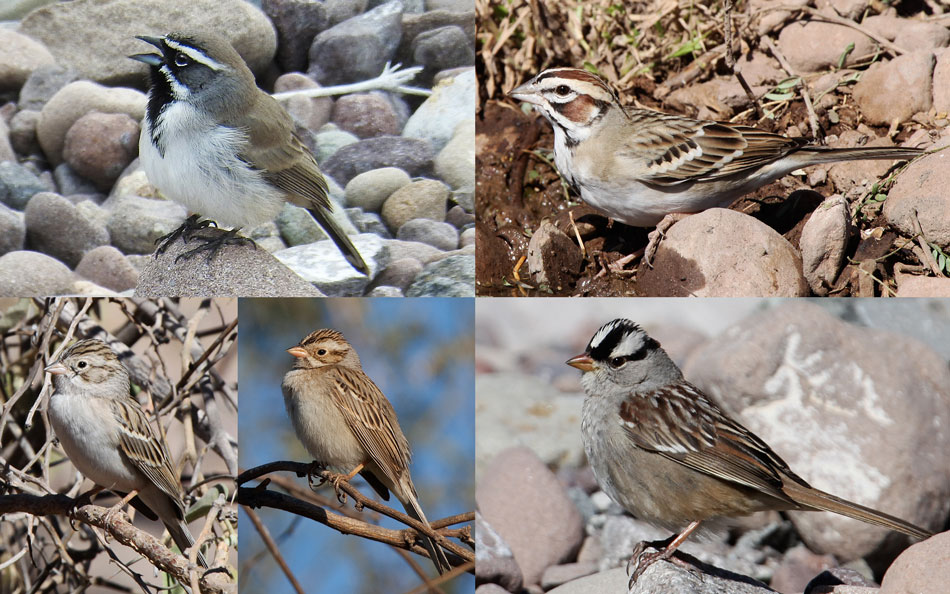
Photos courtesy of Tom Haglund
Photos from top left, clockwise: Black-throated Sparrow, year-round resident; Lark Sparrow, easy ID that comes in early fall; White-crowned Sparrow, another easy one when mature, not so easy when young; then there’s this crew: Brewer’s and Clay-colored Sparrows.
By Tom Haglund
It’s that time of year again; when those easy summer sparrow IDs have gotten pretty complicated. From spring until almost fall there are really only two species of sparrow here, and they look nothing alike. The lowly, and very urban, invasive House Sparrow and the lovely and people-shy Black-throated Sparrow look about as much alike as a burro and a horse, so times are easy for a bird watcher when they’re the only two sparrows in the neighborhood.
Well, that’s all over with now as migrating sparrows came pouring in from the north to spend their winter in this much warmer locale. Some are still pretty straightforward to identify. Bold facial markings and other differences stand out among such visitors as Lark Sparrows and mature White-crowned Sparrows, but missed IDs among other species are nearly unavoidable. Line up Brewer’s, Clay-colored, and Chipping Sparrows and sorting them out can be a real challenge. Likewise; Savannah, Song, and immature White-crowned Sparrows are easy to mix up.
Add to all this confusion the fact that the birds are often moving around in mixed flocks, molting and maturing at varying rates, and that the whole natural world abounds in cases of individuality; and you have a recipe for a season of, “I think maybe . . .” It doesn’t help much either that they are almost constantly in motion. Even with your photo up on a big computer screen and the guidebook in hand, sometimes ya gotta just suck it up and say, “That’s another LBJ (little brown job) for sure.”
Spanish names:
House Sparrow – Gorrión Doméstico; Black-throated Sparrow – Gorrión de Garganta
Negra; Lark Sparrow – Gorrión Arlequín; White-crowned Sparrow – Gorrión de Corona
Blanca; Clay-colored Sparrow – Gorrión Pálido; Chipping Sparrow – Gorrión de Ceja
Blanca; Brewer’s Sparrow – Gorrión de Brewer; Savannah Sparrow – Gorrión Sabanero; Song Sparrow – Gorrión Cantor
How to Support Eco-Alianza Financially
Several Eco-Alianza supporters have asked us the best way to donate to Eco-Alianza, and the answer is fairly simple. Of course we always accept contributions of checks or cash at our CenCoMA office in downtown Loreto. However, our office hours are somewhat limited due to the pandemic, and you may be like many supporters who are not in town anyway.
The easiest way to donate is generally online, through the donation link on our website. That link will connect you to our portal at the International Community Foundation (ICF), which processes donations for us and for many other small nonprofit organizations. Donating through the portal on our website ensures your contribution will be credited to Eco-Alianza. It also makes your donation tax-deductible in the United States, and you will receive a tax receipt directly from ICF. Options are available for one-time donations or automatic monthly support.
Some supporters prefer to contribute through their individual charitable funds at Fidelity, Schwab or other financial services firms. Of course those donations are entirely welcome, and generally arrive in the form of a check sent to ICF. It’s critical that those checks specify the Amigos de Eco-Alianza Fund at ICF, and not simply ICF. Please contact us for additional information necessary for financial managers to prepare the check.
Lastly, if your employer offers any form of a matching donation program, it’s usually a matter of filling out a very simple one-minute form, to essentially double your donation. Thank you so much for considering this option!
2021 Calendars Still Available
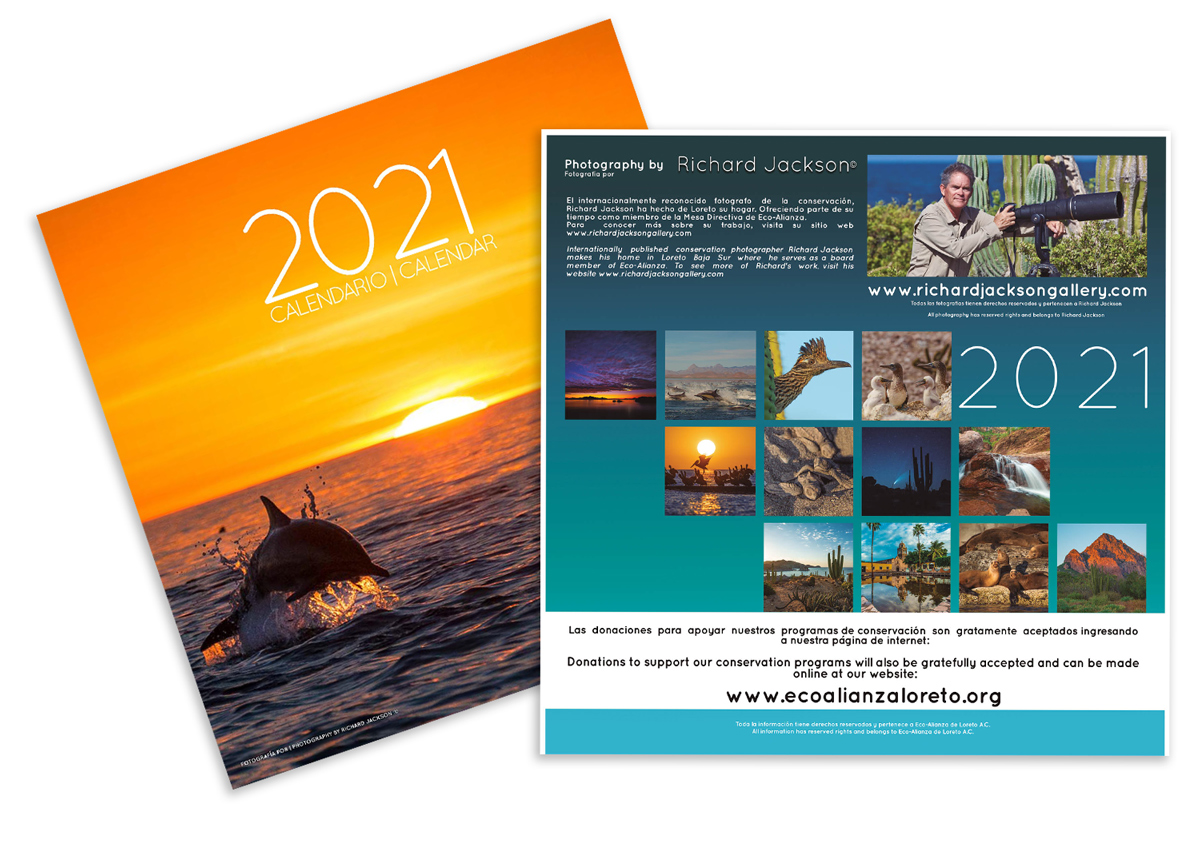 A few of our beautiful 2021 calendars, featuring the stunning wildlife photography of Richard Jackson, are still available at our CenCoMA headquarters or at several shops around Loreto.
A few of our beautiful 2021 calendars, featuring the stunning wildlife photography of Richard Jackson, are still available at our CenCoMA headquarters or at several shops around Loreto.





